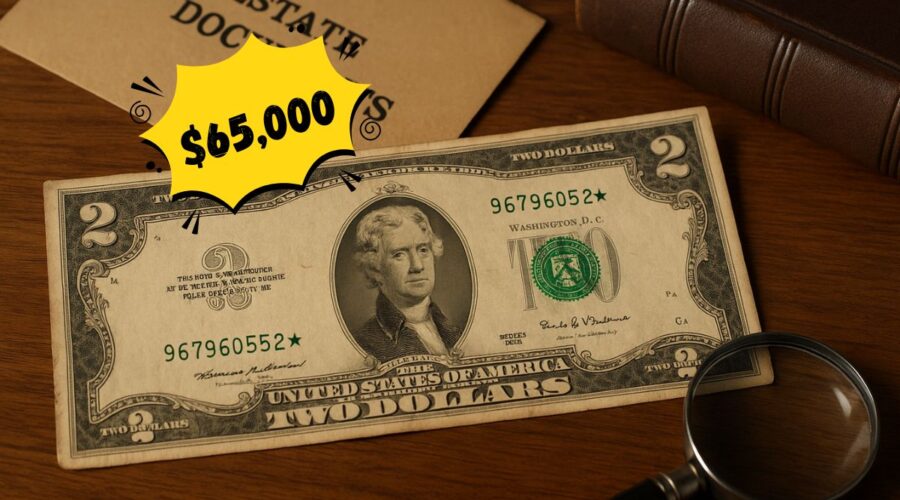Inherited $2 Bill Turns Out to Be Rare 1928 Star Note Worth $65,000
Imagine discovering that a seemingly ordinary $2 bill tucked away in a family heirloom is actually a rare collectible worth tens of thousands of dollars.
This is precisely what happened when an individual inherited a 1928 $2 Star Note, later appraised at an astonishing $65,000.
This article delves into the fascinating world of rare currency, exploring the significance of star notes, the unique features of the 1928 series, and why certain bills become highly valuable to collectors.
The Remarkable Discovery
In a recent event that has captivated currency enthusiasts, an individual inherited a 1928 $2 Star Note from a relative. Initially perceived as a sentimental keepsake, the bill’s true value came to light upon closer examination.
The presence of a star symbol in the serial number indicated it was a replacement note, a detail that significantly increases its rarity and value.
Understanding Star Notes
Star Notes are replacement banknotes issued by the U.S. Bureau of Engraving and Printing to replace misprinted or damaged notes.
Instead of reprinting the same serial number, a star is added at the end of the serial number to denote its replacement status. These notes are produced in smaller quantities, making them more sought after by collectors.
The 1928 $2 Star Note: A Collector’s Gem
The 1928 series marked the first issuance of small-sized U.S. currency, transitioning from the larger notes previously in circulation.
The $2 notes from this series featured a red seal and a portrait of Thomas Jefferson on the obverse. The reverse depicted Jefferson’s Monticello estate.
Among the 1928 series, certain star notes are exceptionally rare due to limited print runs. For instance, the 1928B $2 Star Note is considered one of the rarest, with very few known to exist in uncirculated condition.
Factors Contributing to the $65,000 Valuation
Several elements contributed to the high appraisal of the inherited 1928 $2 Star Note:
- Rarity: Limited production numbers of star notes in the 1928 series, especially certain sub-series like 1928B, make them rare finds.
- Condition: The note’s preservation in near-mint condition significantly boosts its value. Collectors place a premium on notes with minimal wear and crisp features.
- Historical Significance: Being part of the first small-sized currency series adds historical value, appealing to collectors interested in pivotal moments in U.S. monetary history.
Comparative Values of 1928 $2 Star Notes
To provide context, here’s a table showcasing the estimated values of various 1928 $2 Star Notes based on their series and condition:
| Series | Estimated Value (Circulated) | Estimated Value (Uncirculated) |
|---|---|---|
| 1928 | $7 – $20 | Up to $75 |
| 1928A | $50 – $80 | Up to $275 |
| 1928B | $70 – $175 | Up to $1,000 |
| 1928C | $10 – $20 | Up to $90 |
| 1928D | $5 – $12 | Up to $45 |
| 1928E | $10 – $25 | Up to $85 |
| 1928F | $4 – $15 | Up to $35 |
| 1928G | $5 – $10 | Up to $25.50 |
Note: Values are approximate and can vary based on market demand and specific note characteristics.
The Broader Impact on Currency Collecting
This discovery has reignited interest in paper currency collecting, highlighting the potential hidden value in everyday items.
It serves as a reminder to examine old bills carefully, as rare notes can sometimes be found in personal collections, passed down through generations.
The unexpected discovery of a 1928 $2 Star Note valued at $65,000 underscores the hidden treasures that may lie unnoticed in our possessions.
This event not only brings attention to the fascinating world of currency collecting but also serves as an inspiration to explore and appreciate the historical artifacts that might be tucked away in our own homes.
FAQs
How can I identify a star note?
Look at the serial number on your bill. If there’s a star symbol (*) at the end of the serial number, it’s a star note, indicating it was a replacement for a misprinted or damaged note.
Are all star notes valuable?
Not necessarily. While star notes are generally rarer than regular notes, their value depends on factors like the series, denomination, condition, and demand among collectors.
Where can I get my old currency appraised?
You can consult with professional currency dealers, attend coin and currency shows, or reach out to numismatic associations. Online platforms and auction houses specializing in currency can also provide appraisals.


Leave a Reply